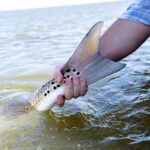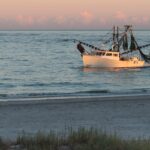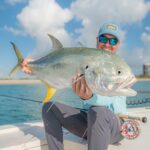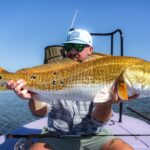
Bowfishing Banned in Biloxi Marsh
Feature Photo: Carter Abramson | Simms Fishing at the Fisheries Science Symposium We have more
Header Photo: Camden Spear
Over the past several years, ASGA has consistently championed science-based, precautionary management of Atlantic striped bass to ensure the long-term sustainability of this iconic fishery. Recognizing the current status of the fishery, ASGA has actively supported management measures aimed at reducing fishing mortality and rebuilding this fishery. In recent years, striped bass advocacy has increased to great heights. As a result, there have been more recent conservation wins than losses. That being said, the ASMFC Striped Bass Board always finds ways to avoid taking the most conservative route for managing this resource. Now that we are approaching the ASMFC’s 2029 rebuilding deadline, it appears as though we are running out of options.
Last year, we learned that striped bass harvest was projected to increase by 17% from 2024 to 2025 as the 2018-year class matured into the slot size. In a continued effort to guide sustainable management of this iconic resource, the ASGA team tried to find a management path to prevent this harvest increase and preserve the last decent-year class of striped bass. As a reminder, fishing mortality for striped bass has cratered—directed trips per year, and the amount of fish caught per trip continues to trend downward. Per the latest update from the ASMFC Striped Bass Board, we have a 48.5% chance of rebuilding to target by 2029 if we do nothing. We need a 7% reduction to get to a better than 50% of rebuilding.
Our solution was to move the slot down to allow the 2018-year class to “jump the slot” (and not be subject to substantial legal harvest). The campaign for a lowered slot was not solely based on intuition. The angling community recorded over 10,000 striped bass through the GotOne app in the last two years. That data contained release lengths, surveys, and pictures. This is the same app our community used to contribute data to the Massachusetts Division of Marine Fisheries’ Striped Bass Survey. GotOne’s striped bass catch data was validated beyond any reasonable doubt. The compiled catch data clearly showed a lack of smaller fish. When the distribution of those recorded fish was plotted again with consideration for the standard growth rate for those fish in a calendar year, it showed the largest cohort (2018’s) of those fish moving into the unchanged legal slot size (with very few fish smaller than that slot). If the slot had been adjusted to a shorter total length, harvest would not have substantially increased. We were told that shifting the slot to a smaller size would significantly increase harvest. We questioned where that abundance of smaller fish was represented in sound data, only to find out on a future Technical Committee (TC) call that the concept was supported by minimal intercepts. At the time of this public engagement, our offer to share a more robust data source for consideration was rejected. It was disheartening, to say the least.
Rather than follow in the footsteps of conservation-focused leader Mike Armstrong (from Mass DMF), the current ASMFC Striped Bass Board chose to initiate Addendum III. This decision meant that no action could be taken in 2025. Addendum III quickly grew into a monstrosity. They “hung so many ornaments on the tree” that the Technical Committee struggled with the analysis. The assumptions made for no-targeting closures are far from reality. When you put bad data in, you get bad data out. We are now faced with taking Addendum III across the finish line, which will amount to nothing more than a waste of resources.
The meeting in the first week of May began with a motion to remove all the harvest restrictions from the Addendum. That vote failed on a tie. If it had passed, Addendum III would have been about commercial tagging and standardizing how to measure a striped bass. Several board members noted that the public would not respond well to a document that does nothing. The “glass half full” perspective of the meeting is that a lot of bad things were removed from draft Addendum III:
The first option removed was an 0.8% commercial reduction. There are some Board members who believe that because the commercial sector contributes around 11% to mortality that their reduction should not be equal. ASGA stands firmly that all sectors and stakeholders who benefit from the resource should participate equally in the conservation of that resource.
Mode splits were also removed. Now is not the time to give charter operations special treatment with a wider slot. Ultimately, this may have been the best thing that happened during the meeting. For striped bass advocates who want accountable management, this is one less thing to fight. The larger slot limit (37-40 and 38-41) was also removed by unanimous consent.
The final notable issue from the last meeting was a proposal for a new striped bass season in Maryland. You need a quantum computer to figure out when and where you can fish in the Maryland portion of the Chesapeake. There are no targeting closures, spawning river closures, and staging area closures. All these issues are Maryland DNR’s fault. At each step along the way, Maryland placed all the burden of rebuilding on the recreational sector. It resulted in a disaster for private anglers, light tackle guides, tackle shops, and other fishing-related businesses. These newly proposed changes bring Maryland closer to other bay jurisdictions. Two more amendments were placed on the motion. First, the TC must further review the proposal. Second, the TC must submit an option that includes a 10% buffer that accounts for uncertainty. With those two additions, we are open to seeing the final numbers on the proposal. Notably, this motion would back Maryland into a corner if reductions pass. The commercial sector in Maryland will have a very difficult time avoiding a quota cut this time around.
So, this new proposal is now going back to the TC. There is nothing to comment on until September. We have been promised that this extra analysis won’t cause further delays to public participation and implementation of the Addendum.
Addendum III could very well end up doing more harm than good. The last tools in the fishing mortality reduction toolbox are no-harvest and no-targeting closures. We support small no-harvest closures. Those are measurable. We do not support no-targeting closures in the ocean. In the Chesapeake, there are environmental concerns as well as a lack of other species to catch. Neither of these factors exists on the coast. People will fish for bluefish, weakfish, albies, bonito, and just about anything else. What happens when a party boat is on a wreck fishing for black sea bass and a client catches a striper? Do they have to move? How about just giving the ocean over to the commercial sector during those closures? There was some confusion in the past that no-targeting applied to all striped bass stakeholders. For clarity, those closures are only for the recreational sector. The commercial fisheries will go on while the recreational community is not even allowed catch and release.
The technical committee also gave guidance that any closures shorter than 14 days is impossible to quantify. How much sense does that make? Here is the chart:

The proposed regulations are based on two distinct regions. The first is only spans Maine to Rhode Island, while Connecticut to North Carolina are lumped together. In this chart, you will see waves referenced. A wave in this context represents a two month stretch. For example, Wave 1 is January and February, which 6 waves covering the calendar year.
When it comes to striped bass, Maine and New Hampshire harvest very few fish. That is why their closures are significantly longer. It takes weeks of closure in the northernmost states to equal the “same amount of fish spared from harvest” in just a few days further south. When you dig into this chart, you can plainly see how certain states could benefit wildly while other states would be crushed. These regulations disproportionately burden the states that catch and kill LESS fish. Meanwhile, a state like New Jersey can opt for nine-day closures in Wave 6 (November and December) and Wave 4 (July and August) when the fish just aren’t there (close at the very end of December?), and pretty much gets off scot-free. For years, we have heard the concept of disproportionate burden used to defend the commercial industry from taking significant accountability and appropriate reductions. We also hear a lot about “equity”. How is it equitable that one state has the longest season and gets to kill two fish per person per day for about 6 months of that season? They also don’t have a fishing license, and therefore next to zero enforcement. Now those same voices at the management level are playing the other side of the coin, pushing for regulations that would have a significantly larger impact on states that are a smaller share of the issue.
Our tenured supporters may feel a lack of relentless, rowdy advocacy often associated with our Association. The shameful reality is that Addendum III was not started by the Board to conserve fish. Addendum III was kick started to delay action in 2025 and ensure bad actors had the entire calendar year to kill as many 2018 fish as possible. Those bad actors were successful in their efforts because they pitted the rest of the coast against each other with an impending threat of no-targeting, and those other states balked.
Here’s the elephant in the room that those same actors know but will never admit: we are currently enduring the worst 6-year stretch of striped bass spawning ever recorded. If we have a 7th straight bad spawn, all bets are off. There will be no other path forward but a harvest moratorium. This Board’s ability to consistently wriggle its way out of accountability will have finally caught up to it. Addendum III did exactly what it was intended to do: delay action to have one last hoorah on the final good year class.
The benchmark stock assessment is scheduled for 2027 – and it is highly likely that fundamental change is looming behind the results of that stock assessment. And when the science leaves at a dead end with no other option but the “M-word”, we will fight to the end to ensure these fish get long overdue relief, so maybe our grandchildren will have a chance to grow up catching striped bass. Our position as an Association has been consistent for years. We have never taken anti-commercial or anti-harvest stances, trying our best to represent the resource with respect for all stakeholders. Unfortunately, this Board continues to fail with their hands on the reins, and it feels like the only path to a bright future for this fishery is if their hands are removed from management.
As always, we will attend all the upcoming meetings and provide insights on the various proposals. There is still a chance that Addendum III will fall apart at the August meeting. Regardless, we will provide all the resources necessary to participate in the process.

Feature Photo: Carter Abramson | Simms Fishing at the Fisheries Science Symposium We have more

Each year, hundreds of millions of fish are killed as collateral damage from large-scale, inshore

Feature Photo Credit: Scientific Anglers Team At the heart of the Jack Project is a

Photo Credit: Carter Abramson | Trevor Johnson Every now and then, we encounter something so
We rely on our members and donations to keep fighting for a sustainable tomorrow in marine conservation.
GIVE THE GIFT OF FISHERIES CONSERVATION THIS HOLIDAY SEASON. SHOP ASGA GOODS THAT FUND FISHERIES RESEARCH & ADVOCACY CAMPAIGNS
JOIN ASGA IN CALLING FOR CRITICAL MANAGEMENT ACTION AFTER YEARS OF SPAWN FAILURES & POOR MANAGEMENT.
By using this website, you agree to our use of cookies. We use cookies to provide you with a great experience and to help our website run effectively. To learn more, please review our privacy policy.
7 Responses
Initiate a moratorium now on Striper fishing for everyone!
“In the Chesapeake, there are environmental concerns as well as a lack of other species to catch. Neither of these factors exists on the coast.”
In reference to the above statement, I respectfully disagree, or maybe I am confused about what you are suggesting. I live a stone’s throw from the open, western Chesapeake Bay in VA. At various times of the year, there are plenty of other species to catch in the Chesapeake … red drum (big ones as well as puppies), cobia, speckled trout, flounder, spanish mackerel, bluefish. Certainly not in the large concentrations that striped bass can be found in (at certain times of the year), but they are there. And reasonably large numbers of these striped bass are in the 21″-27″ class. VA has done a good job setting the limit at 19-24″, one per day (with seasonal closures). But a lot of overslot fish must be released, potentially increasing mortality. Would a couple of years of no-targeting (not really enforceable) or closure be so bad so as to allow the 25″-27″ fish grow up to be breeders?
John,
There aren’t no-targeting closures in VA. You can catch and release. The reference was to the Maryland portion of the Chesapeake. Throwing a fish in a cooler has a much higher mortality rate than catch and release. The last part of the quote, “Neither of these factors exist on the coast” is in reference to the coastal fishery, which is managed separately from the bay jurisdictions. There are multiple species that are available in the same locations while using the same techniques as you would for stripers. No-targeting was listed as the least enforceable management action on the coast by law enforcement. It is ridiculous to consider a management regime that law enforcement is rejecting. It is not quantifiable, and the assumptions being made to quantify it are nothing short of false. No-targeting is being pushed by parties that want to continue to harvest and have no other recourse but to ban fishing for parts of the year, so they don’t have to take a reduction. That is the ugly truth. A harvest moratorium is very quantifiable.
The only responsible choice is a full moratorium.
It’s regrettable, but it’s required due to the abysmal state of the fishery.
Commercial harvesting need to end, for the entire coast, period. Talk about getting the most diminished value for a limited resource. If states can’t agree on that, the fishery is doomed. Rec reform is necessary as well, but the commercial harvest has to stop. Otherwise this is pissing in the wind.
“Our tenured supporters may feel a lack of relentless, rowdy advocacy often associated with our Association. ”
When I read this in your excellent coverage and explanation of what went on at the latest ASMFC Atlantic Striped Bass Management Board meeting, I was hoping that you would delve more into the reality of the inability of any conservation group to impact striped bass management.
Despite well intended, respectful, and responsible approaches to conservation that the ASGA
has promoted, it sounds like you have reached the breaking point. As you say,”we will fight to the end to ensure these fish get long overdue relief, so maybe our grandchildren will have a chance to
grow up catching striped bass. Our position as an Association has been consistent for years. We have never taken anti-commercial or anti-harvest stances, trying our best to represent the resource with respect for all stakeholders. Unfortunately, this Board continues to fail with their hands on the reins, and it feels like the only path to a bright future for this fishery is if their hands are removed from management.”
The board has some really good people on it, but they, too, have proven ineffective in the face of politics and ignorance. I’m not sure what you meant exactly when you said “if their hands are removed from management.” I assume it means that a moratorium by its very nature will leave them with no choice and no games to play.
Personally, I favor the abolition of the ASMFC in its current format. Frankly, I don’t know if this is even possible. Anyone who has read STRIPER WARS knows that it took action on a federal level to get things done, but we don’t have any politicians like Gerry Studds and Claudine Schneider who were willing to play hardball to save the bass.
Heck, apparently we don’t have any politicians at any level who give a shit about stripers or any other fish for that matter. They’d rather hold hearings to get face time to win re-election and spread whatever false propaganda that their side espouses.
I admire the ASGA and other groups for not pointing fingers at non-recreational sectors of the fishing community – and even the miscreants who hide under the recreational banner – but enough is enough. I’ve watched and written about this circus for over 30 years and this system is broken.
In conclusion, to paraphrase the famous movie line, I wonder how many folks out there are willing to say, “I’m angry as hell and I’m not going to take it anymore” and help the ASGA and others through getting their hands dirty and take up the fight.
Sorry for the rant and feel free to delete it.
My understanding is that the commercial striped bass sector, at least in NY, as per the NYS DEC, does not cause any bi-catch mortality and mortality is not considered their commercial landings report. As per the NYS DEC striped bass administrator, SB landings are based on number of tags reported as used versus unused, they consider no other data or mortality calculation factor. I find this very hard to believe as I have witnessed draggers hauling back and dumping dozens of over-slot sized fish in the water half-dead and then watch them float away dying. Also, have witnessed fixed position gill netters discard numerous out-of slot fish, and lastly commercial pin hookers lip gaffe big bass, bounce them off the deck and launch them into the water. Lastly, tagging does not have to take place at time of catch, but time of boxing. I am not against commercial fishing, but we need a realistic view of take and mortality all around.
I truly believe that the 11% number is badly flawed, should be adjusted upward and the commercial sector should be throwing in equally regarding reductions. I am also interested if other states with a commercial SB fishery consider mortality in their reported SB landings.